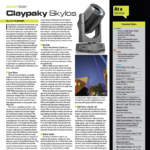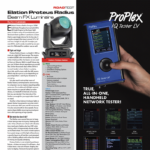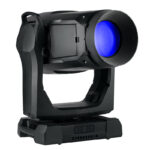The image of a katana is one of refined elegance, a gracefully curved blade so sharp as to cut the very air before it. Like its namesake, the Katana from DTS Lighting aims to provide a sharp and dramatic blade of light cutting through the darkness, but it’s more than just a linear batten — the Katana comes with a few tricks to keep things interesting. DTS is an Italian company that has been in the lighting business since the 1980s, and this is their first motorized linear batten light. The form factor here is typical of some other motorized battens — a linear “head” with the LED dies and optics, and a base with the power supply, menu system and electronics.

Light Source
On the face of the fixture are twelve 20-watt Ostar LED packages from Osram, with red, green, blue and white. These are square COB-style packages that sit on a board under the moving zoom element. The LED dies and electronics of the light together draw around 300 watts at full tilt. One might be forgiven for thinking that there are three zoom sections in this light, as there are three clearly-delineated “sections” of four lenses grouped together, but this is not the case. Zoom is global across the fixture. The output lenses are somewhat large, around two inches across, and they are evenly spaced across the face of the unit.
The output from these LED packages are very well homogenized. I saw no multicolored shadows anywhere throughout the range. The dimming is reasonably smooth, and the unit provides two dimming curve options for the user to choose from: a linear curve, and one they call “quadratic.” Their quadratic curve resembles a square law curve, while the linear curve very closely follows an ideal linear curve. There is some minor stepping in the last 10 percent of the dimming range, something to be aware of when programming slow fades to black. I measured an initial output with all emitters at full at 4,920 lux and again after reaching thermal equilibrium, and read an output drop of 82 percent of initial levels (4,040 lux).
The blue is quite deep (460nm), so keep that in mind when mixing with other fixtures in your rig, and the white emitter helps immensely when mixing subtle pastels or skin tones. The default PWM (Pulse Width Modulation) frequency is 610 Hz, and like many other fixtures on the market today, this frequency can be adjusted up or down to prevent flicker issues with cameras. Adjusting the PWM can increase the “steppiness” of dimming, so DTS provides a menu option to add a fade time to the LEDs to help smooth out the steps, adjustable from 0ms to 20ms. This setting is global; it affects the dimming channel as well as the color channels.
The fixture has three personality modes — Standard, Chase and Extended. In standard mode, all the pixels behave as one fixture. Chase mode adds a variety of built-in chases and effects. Extend mode gives users individual control over all the pixels in the light. There’s also a strobe channel here, which affects the entire fixture globally, and it includes synchronized strobes, random strobes and pulses. In chase mode, the user can overlay various built-in effects over their own colors and sequences. I was able to get some interesting effects very quickly using the built-in chase channels.
Optics and Zoom
The zoom on this fixture ranges from 3.5º to 30º, and it covers its entire range in a fairly snappy 0.44 seconds, fast enough to use as an effect or a chase in your rig. At its narrowest range, the fixture’s LED chips are nearly perfectly in focus, leaving a solid line of luminous squares on projected surfaces. The narrow range of the zoom, which DTS calls “Blade mode,” produces some very nice aerial effects and projects a nice beam in mid-air. The fixture also includes a CTC channel that smoothly adjusts the color temperature down to 2700 Kelvin. Output percentages of individual emitters added up to more than 100 percent, indicating some load-sharing going on among the various colors.

Movement, Power and Control
Tilt was fairly fast, with the fixture covering its entire 190º tilt range in around 0.91 seconds. This is in 16-bit channel mode, and positioning was accurate and very smooth, even during extremely long fades. Jittering on even long 30-second sweeps was minimal. Homing the fixture from a cold start to final output look took 34 seconds. When resetting in a look, the fixture will begin outputting the dimmer and color information before the tilt has reached its final position, something to be aware of if you need to reset the fixture during a show. The menu system on this fixture uses the old-style seven-segment display (like the display of a digital watch), which I found rather cryptic and difficult to navigate. I’d recommend having a manual close at hand when setting menu options at the fixture. You can also sidestep this issue by setting options via RDM.
Most of the noise from the fixture comes from the motors, particularly when they home up, but I doubt that this will be an issue for the intended users of this light. Like other fixtures in the DTS line, there is a “Studio Mode” to help in sound-sensitive environments by slowing down the fans and zoom. The Katana also comes with a few different pieces of mounting hardware: there are the expected Omega brackets for mounting to a pipe or truss, but it also comes with a set of floor mounts. These floor mounts also attach via the common quarter-keys, and they have convenient handles on either side, which make carrying the fixture by one or more people very easy.
Power is provided by Neutrik PowerCON TRUE1 in- and pass-throughs, and it auto-ranges from 90-260VAC. DMX input is via five-pin connectors and RDM is supported. Weighing in at 35.25 pounds (16 kilograms), the Katana is 42.5” (1078mm) long by 11” (280mm) high and 3.5” (90mm) wide.
The Katana enters a busy sector of the market, offering users an enticing combination of brightness and a wide feature set. With its well-homogenized light output, fast zoom and smooth tilt, the fixture will appeal to those who need a light that isn’t just another batten.
At a Glance
Not Just a Linear Batten
The Katana provides powerful sweeps of light and convenient built-in programming tools for getting the most out of it quickly. More than just a linear batten, this is a serious lighting tool with both output punch and smooth optics, and should be at home on tours, special events, and houses of worship.
DTS Katana
PROS: Great zoom range, bright output, nice pastels, fast tilt
CONS: Menu display is difficult to understand
STATS:
- Light Source: 12 20W Osram Ostar RGBW LEDs
- Color Temp: 2700-8000K
- Total Wattage: 300W
- Zoom range: 3.5-30°
- Tilt Range: 190º
- Control: RDM, DMX 512, LED display w/four soft keys
- Firmware Updates: Via DTS Red Box
- Certifications: LED class 2, CE
SPECS:
- Size: 42.5 x 11 x 3.5”
- Weight: 35 lbs.
- MSRP: $3,500
- Manufacturer: DTS Lighting
More Info: www.dts-lighting.com



